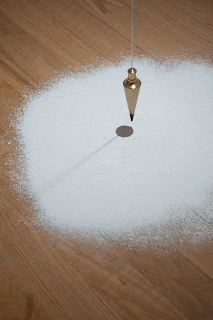JILL DOWNEN ON BEING AND SPACE IN
COUNTERPARTS AT
OKCMOA
"Threshold," 2011 is a flow of plaster or gypsum dust on the
wood floored gallery. Photo by Joseph Mills
By Nancy Condit
In sculptor Jill Downen’s current show Counterparts at the Oklahoma City Museum of Art, Downen continues to explore the concept she’s been interested in for over 20 years: the symbiosis between the human body and architecture. Her exhibit is part of the NEW FRONTIERS Series for Contemporary Art that “underscores the museum’s commitment to the art of our time and to recognizing contemporary art as a critical and dynamic part of our daily lives,” writes Glen Gentele, exhibit curator, and museum president and chief executive officer, in the exhibit brochure. The exhibit continues through May 1 in Oklahoma City
A “Plumb Line with Spot of Threshold,” 2011 in the center of the gallery, pointing to a pool of plaster dust on the wood floor, drew this writer’s most continual attention, perhaps because of its placement, the shine of light off the brass, or an absolute line it sets, while the sculpted body parts are in differing stages of age. It’s a “meditative center, a center of being” placed over the material the artist used to fabricate the other parts of the exhibit, Downen says in her video on the OKCMOA website,
"Plumb Line with a Spot of Threshold," 2011 is Counterparts'
"meditative center, a center of being," says Downen.
Photo by Joseph Mills
The other most attention-drawing piece was “Threshold,” 2011, a flow of plaster or gypsum dust on the wood floor against a 60’ white wall. “’Threshold’ signals the edge of a void, a zone between the material and immaterial, inviting viewers to an edge of being,” Downen said by phone
The exhibit is set up as a workspace, with sculptured abstract plaster body parts, some purposely cracked, like “Torso,” 2011 mounted on a high workman’s support pedestal or sagging, like long strands of “Architectural Cartilage on Rack,” 2011, were allowed to slump as they would with age, and were stored on wooden storage racks like those Downen had seen at the Louvre.
The most elegant piece is the “Tendon on Pallet,” 2009, which at first glimpse looks like a sail. The “Breast Blocks on Pallet,” 2009 extend back from the breasts into squared rectangles so they can be stacked and used as building blocks, like bricks.
“I consider all of the installation parts as acting as counter balances. The entire space becomes a one,” Downen writes by email of the exhibit’s title, Counterparts, by email.
The honey colored floor boards of the gallery was a good foil for the stark white plaster, and became part of the exhibit. How would the flow of plaster or the breast blocks on the wood pallet have been seen on a white tiled floor, on a black linoleum one?
In an email interview, ereview.org asked Downen how architecture and the human body are symbiotic, noting her point that people need food, shelter and clothing.
“The symbiotic relationship between architecture and the human body touches all aspects of being. Beyond its function as a second skin, which provides the basic need of human shelter, architecture permeates our senses through its physical and non-physical presence, spatial dimensions, materials and quality of light. The human body is the vehicle for understanding and creating the world around us. The built environment is a prolongation of the self.”
How did this idea start, or how did it approach you?
“The idea first approached me in childhood. Without my awareness, a deep understanding of the body in space was taking shape in my identity. I learned from parents, who continually labored to modify the architecture of our home for the family’s growing needs, that architecture, like flesh, expands and contracts.”
Was there a particular point or event or funding that enabled you to pursue this idea?
“Over recent years I’ve been fortunate to experience support at key points in my development. This includes a grant and 2004 exhibition from Contemporary Art Museum St. Louis
What is your next project, or expansion of this idea?
“For the Guggenheim Fellowship project. I am working in St. Louis New York City New York
Born in 1967 in Belleville , Illinois St. Louis , Missouri Washington University Washington University
Published by permission of ereview.org.


No comments:
Post a Comment